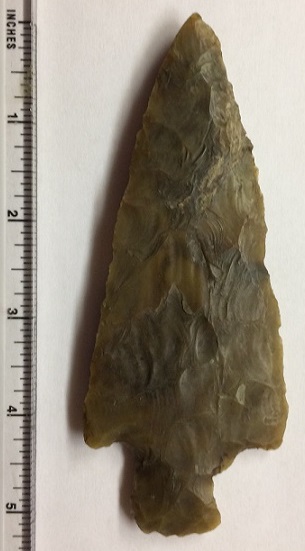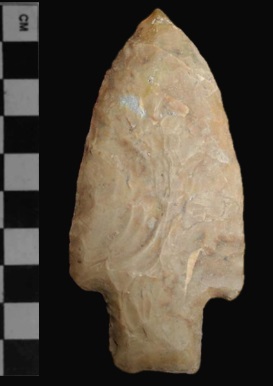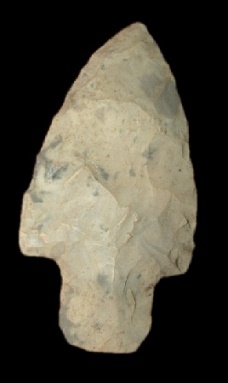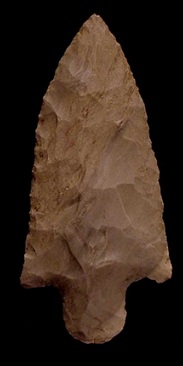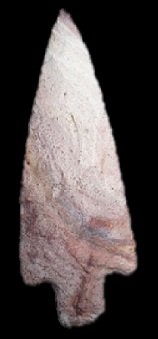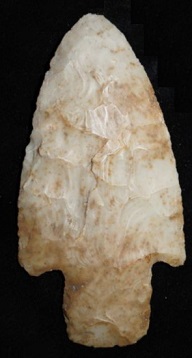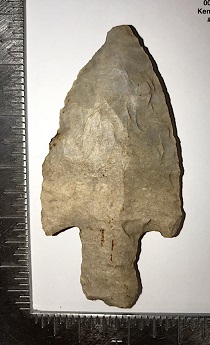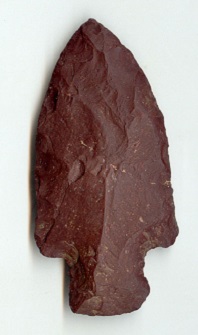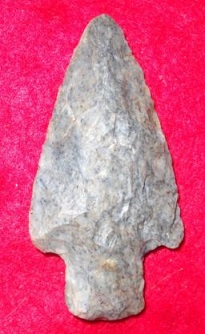Outline is Representative of Size and Shape:
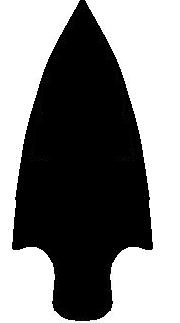
Name Details:
Identified By: Don W. Dragoo
Named For: Type site
Date Identified: 1963
Type Site: Robbins Mound, Boone County, Kentucky
Identified By: Don W. Dragoo
Named For: Type site
Date Identified: 1963
Type Site: Robbins Mound, Boone County, Kentucky
Point Validity: Valid Type
Dragoo is a distinguished anthropologist who publish many books and served as the Curator of the Carnegie Museum. This point was named in a professional publication and has many professional references. This is a valid type.
Robbins Stemmed
AKA: Adena RobbinsCluster: Adena Cluster
Description of Physical Characteristics and Flaking Pattern:
This is a broad medium to large triangular stemmed point with a flattened to elliptical cross section. The blade is broad and primarily excurvate with the widest portion just above the shoulders. The shoulders are pronounced and most commonly slightly barbed, but may be horizontal. The stem is proportionally narrow and square with rounded basal corners. Often the stem is longer than it is wide. The base is primarily straight, but may be convex and lacks basal / hafting region grinding. This point is manufactured with random percussion flaking with pressure flaking used to trim and retouch the blade forming a random flaking pattern.
Size Measurements:
Length - 50 to 150 mm (70 to 80 mm average), Stem Length - 15 to 30 mm (21 mm average), Blade Width - 23 to 55 mm (35 to 40 mm average), Stem Width - 18 to 27 mm (24 mm average), Thickness - 7 to 15 mm (average 9 mm)
Length - 50 to 150 mm (70 to 80 mm average), Stem Length - 15 to 30 mm (21 mm average), Blade Width - 23 to 55 mm (35 to 40 mm average), Stem Width - 18 to 27 mm (24 mm average), Thickness - 7 to 15 mm (average 9 mm)
Commonly Utilized Material:
High quality or locally available lower quality materials including chert, flint, and felsite commonly heat treated.
High quality or locally available lower quality materials including chert, flint, and felsite commonly heat treated.
Additional Comments:
Adena points that are associated with the Adena Culture, are primarily found in the Ohio River Valley. There are many similar points within the Mound Builder Distribution that has similar characteristics to the Adena point. Some of these include the Waubesa point (Hopewell), and the Dickson, Mason, and Florence point (Red Ocher Culture). Adena style points found outside the Adena Cultural area should be evaluated for the possibility it is a similar type.
Points in this cluster were commonly used from the late Archaic period through the early to middle Woodland period (Justice 1987).
Early Adena points seem to be most commonly associated with the Tennessee River Valley and the point seems to spread from there in the early Woodland period (Kneberg 1956), however, the Adena culture is centered (and thought to originate) in the Ohio River valley (W11).
It is thought that the Adena point originated from the Cresap point, and as time progressed variation of this point were developed (W11).
Adena points that are associated with the Adena Culture, are primarily found in the Ohio River Valley. There are many similar points within the Mound Builder Distribution that has similar characteristics to the Adena point. Some of these include the Waubesa point (Hopewell), and the Dickson, Mason, and Florence point (Red Ocher Culture). Adena style points found outside the Adena Cultural area should be evaluated for the possibility it is a similar type.
Points in this cluster were commonly used from the late Archaic period through the early to middle Woodland period (Justice 1987).
Early Adena points seem to be most commonly associated with the Tennessee River Valley and the point seems to spread from there in the early Woodland period (Kneberg 1956), however, the Adena culture is centered (and thought to originate) in the Ohio River valley (W11).
It is thought that the Adena point originated from the Cresap point, and as time progressed variation of this point were developed (W11).
Distribution: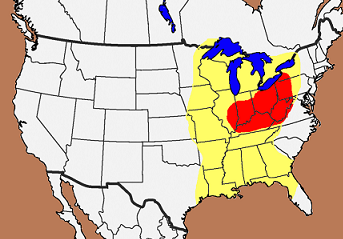

Distribution Comments:
These points are found within the Ohio River Valley. The normal distribution of the Adena points are marked in red (see Additional Comments). The yellow section is the influence and trading network of the Mound Builders which include the Adena, Hopewell, and Mississippian Cultures.
Age / Periods:
Date: 2,500 - 1,500 B.P.
Cultural Period: Woodland
Glacial Period: Neoglacial to Roman Warm
Culture: Adena culture
Date: 2,500 - 1,500 B.P.
Cultural Period: Woodland
Glacial Period: Neoglacial to Roman Warm
Culture: Adena culture
Age Details:
This type is associated with the late Adena Robbins complex of the early Woodland Period (Dragoo, 1963).
This type is associated with the late Adena Robbins complex of the early Woodland Period (Dragoo, 1963).
Similar Points:
Burkett, Elk River, Genesee, Kent, Kramer, Hamilton Stemmed, Hidden Valley, Macon, New Market, Piedmont, Pontchartrain
Burkett, Elk River, Genesee, Kent, Kramer, Hamilton Stemmed, Hidden Valley, Macon, New Market, Piedmont, Pontchartrain
Other points in this cluster / Related points:
Adena, Adena Blade, Dickson, Adena Narrow Stem, Adena Snapped Base, Adena Vanishing Stem, Waubesa, Cresap, Kramer, Fulton Turkeytail, Gary, Harrison Turkeytail, Hebron Turkeytail, Little Bear Creek
Adena, Adena Blade, Dickson, Adena Narrow Stem, Adena Snapped Base, Adena Vanishing Stem, Waubesa, Cresap, Kramer, Fulton Turkeytail, Gary, Harrison Turkeytail, Hebron Turkeytail, Little Bear Creek

